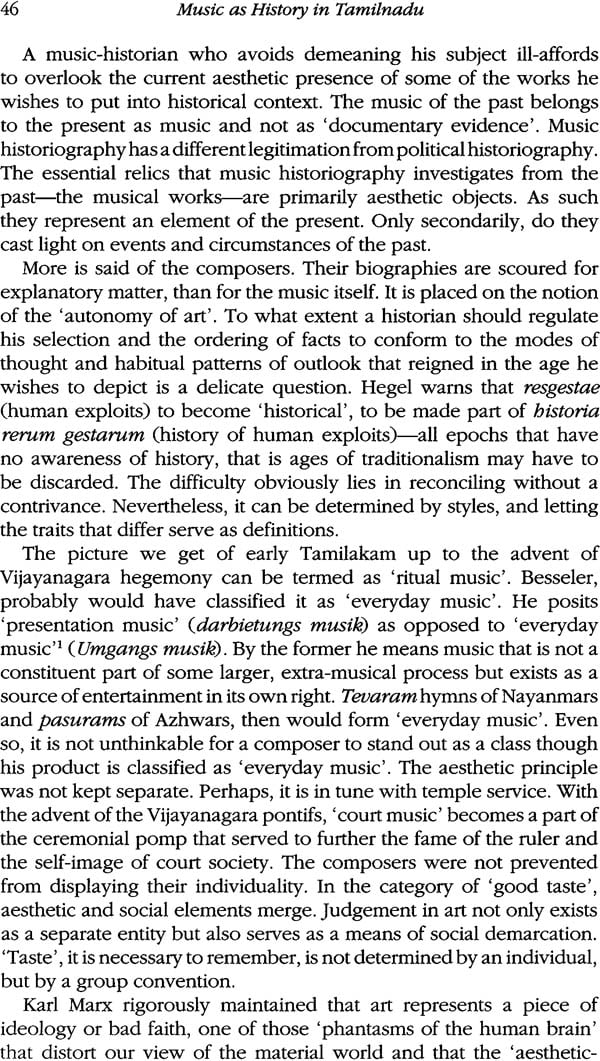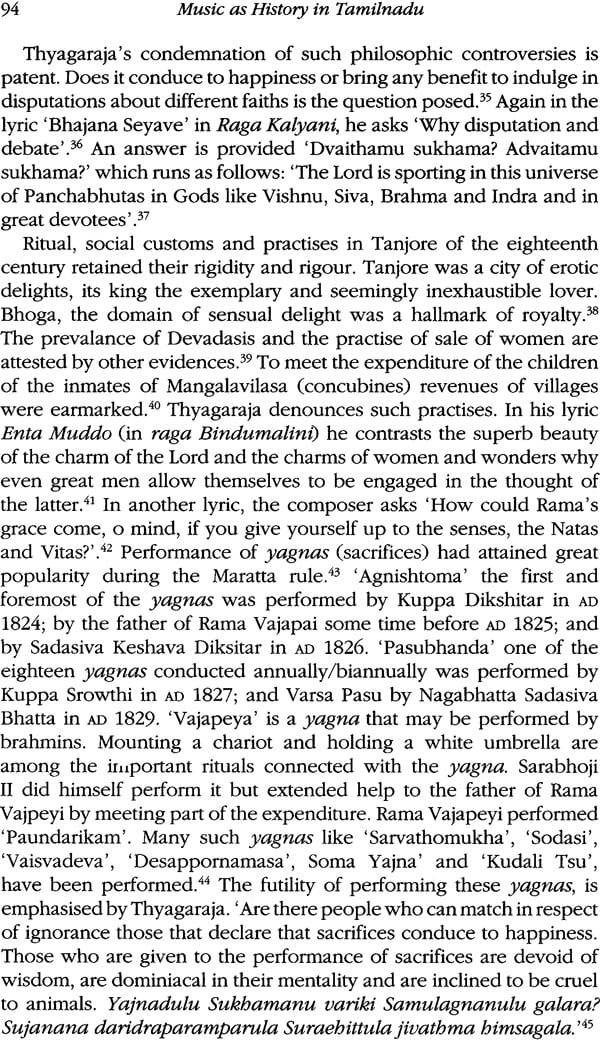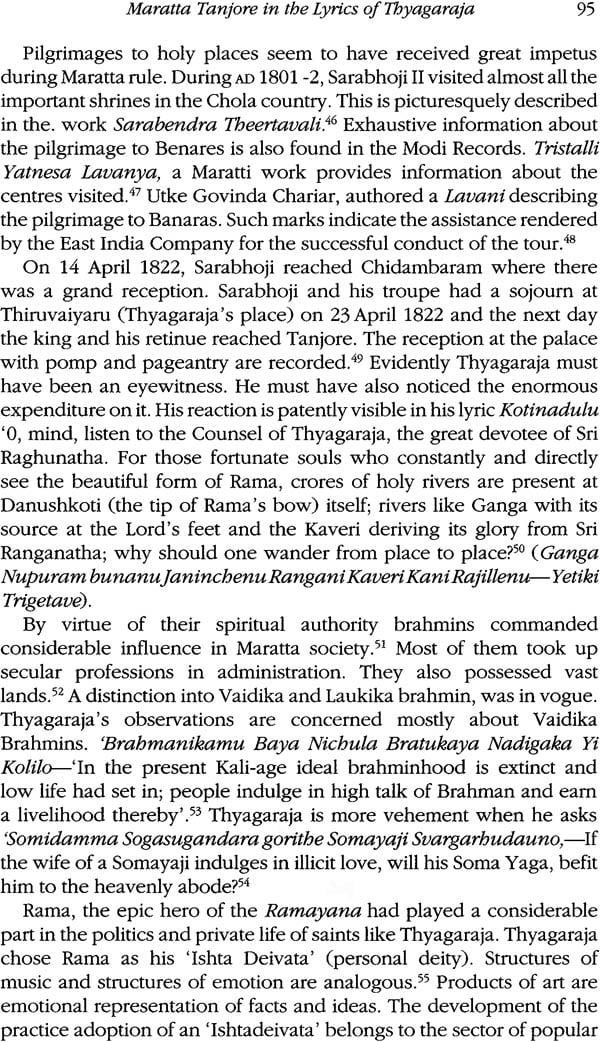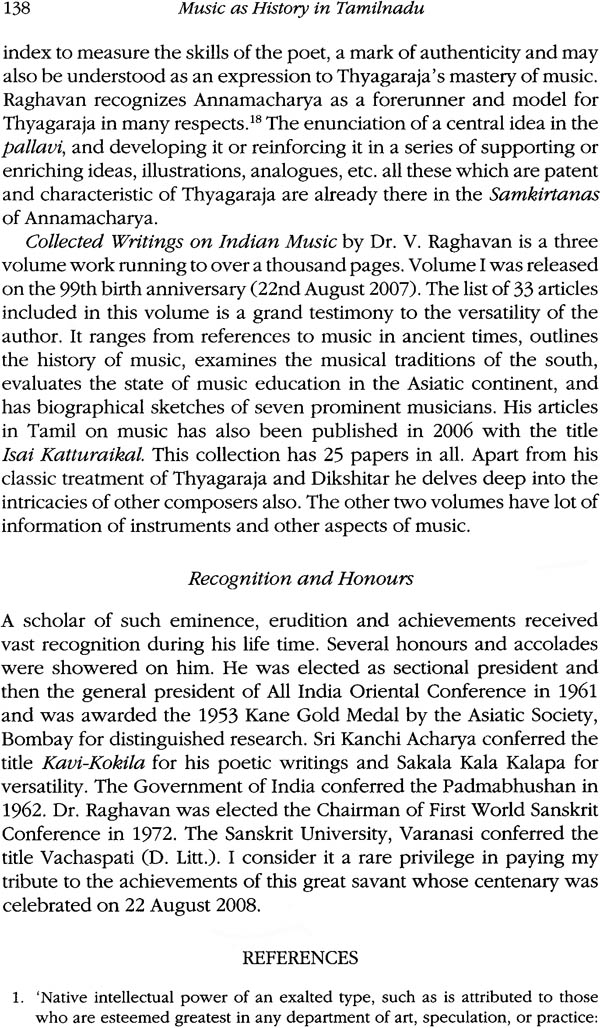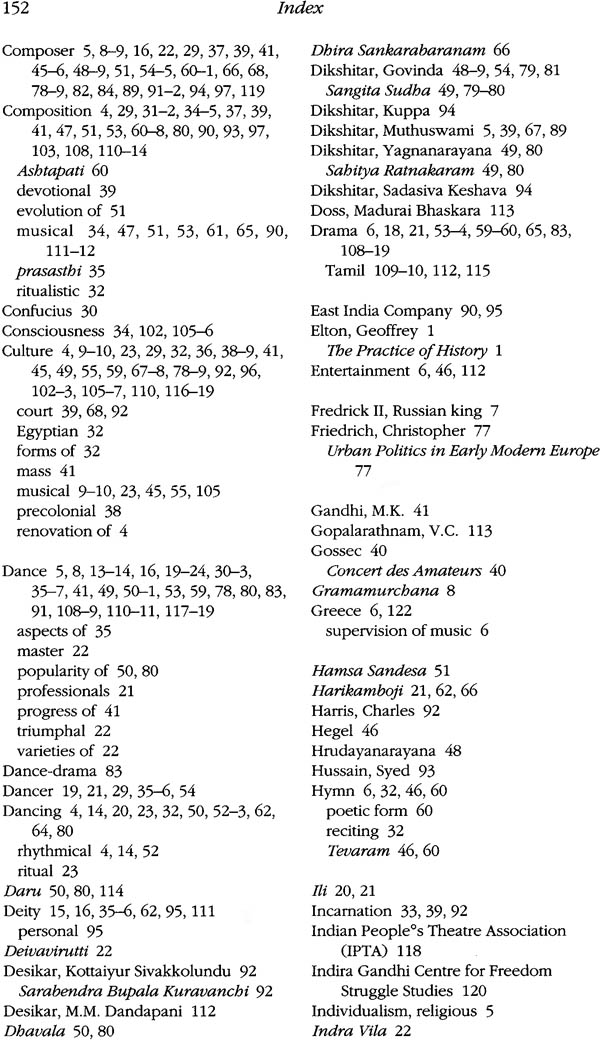
Music as History in Tamilnadu
Book Specification
| Item Code: | NAL976 |
| Author: | T. K. Venkatasubramanian |
| Publisher: | Primus Books, Delhi |
| Language: | English |
| Edition: | 2010 |
| ISBN: | 9789380607061 |
| Pages: | 173 |
| Cover: | Hardcover |
| Other Details | 9.5 inch X 6.5 inch |
| Weight | 490 gm |
Book Description
Recent scholarship on the history of music in South Asia has examined the processes by which music as an art form was reinvented for nationalist purposes, yet, the disciplined study of music (and its aesthetics) remains only a few centuries old. Studying music through a historical lens has opened new approaches to interdisciplinary studies. Music as History in Tamilnadu examines how history can be interpreted through aesthetics and music and vice versa.
Musicologists focus on the study of musical activity, while ethnomusicologists examine this activity first-hand using the ‘field research methods of cultural anthropology. The historian’s task, then, is to interpret the musical past as part of cultural production and thereafter relate music to general historical trends. This collection of essays seeks to establish the interdisciplinarity between music (the Karnatak system) and the history of Tamilnadu, south India.
T.K. Venkatasubramanian teaches at the Department of History, University of Delhi. He is the author of Political Change and Agrarian Tradition is South India, 1600-1800 (1986), Environment and Urbanisation in Early Tamilakam (1988), Societas to Civitas: Evolution of Political Society in South India (1993) and co-author of Rhythm in Historiecal Cognition (1993). He has also co-edited Negotiating India’s Past: Essays in Memory of Partha Sarathi Gupta (2003) and edited Telephonic Counseling in University System (2005).
An accomplished mridangam artiste, T.K. Venkatasubramanian has also learnt classical Karnatak music from renowned vidwans. He is well acquainted with the theoretical norms of the art treatises on music.
Strange as it may strike us, music forms the only substantial cultural factor on which India would admit of a dichotomy into Karnatak and Hindustani systems. Music continues as the solid foundation of a cultural unity called south India or Dakshina Pradesh. This heritage extends from the Pallava- Chola times when the Nayanmars and Azhwars sang their psalms, to our times today, and territorially it binds all the four linguistic states of south India. The indigenous cultural traditions of India had always sought their haven in the south. From the point of view of history, research and reconstruction, what has been preserved in Tamilnadu and Kerals, is of utmost importance to the whole of India.
It is a matter of common knowledge that Indian classical music has its origin in the Saamaveda. Saama is from the Sanskrit root Saama which means ‘to be on the level – in unison’. Another meaning of Saama is simply ‘a song’. Saama has borrowed the maatu, or words of the songs from the Rigveda, but dhaatu, or composition of its music, is its own contribution. The main contriution of the Saamaveda to Indian classical music is (1) musical scale, (2) seeds of the murchana or scale system, (3) rudiments of aesthetics, (4) rudiments of rhythm or taala, and (5) a system of notation.
The great classics of the Sangam age make a favourite theme of music. Silappathikaram given a comprehensive picture. The text is a happy blend of Iyal, Isai Natakam. The evolution of pann (raga), their eleven characteristics, keynotes (take offs) for different pans, exercises on three primary scales, twelve divisions of the octave in the twelve Rasis are discussed in this text according to Tamil musicologists. However, an inscription found at Kudumiyanmalai is of primary interest. Mahendravarman I, the Pallava king is reportedly the author of this inscription. Mahendravarman’s craze for music and his taste for nrittam and layam are borne out by the characters in Mattavilasaprahasana. The music referred to in the inscription belongs to sphere abhayasa gaana (technical exercise) for developing the technique for the finger in playing the vina (Chatushprakara- Svaragama). The name of the vina was Prarivadini, a seven-stringed vina. When the inscription was carved it is probable that the bifurcation of the two systems Hinduatani and Karnatak had not come into existence. An inscription belonging to AD 750 (Nandivarma Pallava III) state that Tirupathigam (singing the praise of God) had become part of temple ritual in the first half of the eight century AD.
The institution of reciting (stinging) the sacred hymns composed by the first three Samayacharyas came into existence in the ninth century AD and that of consecrating their images in tenth century of the Christian era. As endeavours of religious fervor, they grew in intensity through the eleventh, twelfth and thirteenth centuries. Among the Nayanmars, Jnan Sambandha had a contemporary and close association with Nilakantha by name who played the lute (Yazhpanar). A story is recorded that of the tunes of Sambandha could not be reproduced on the tu strind instrument, the yazh. Aanaaya Nayanar, worshipped Siva with his flute music. The music of these times is represented also by the psalms of the Vaishnavite Azhwars whose song were sung, played on the lute, and even rendered in gestures according to tradition. We find reference to music and the lute and the vina, here also.
The Vaishnavite hymns are now recited without music while the Sivite ymns of Tevaram are still sung musically. The music of Tevaram was re-identified again and again and labeled in terms of the nearst approximations to the melodic Mutt Palm leaf manuscripts (AD1742) have the following list of older melodies and their modern approximations:
| 1 | puranirmai | Srikanti |
| 2 | Gandharam | Hejjujji |
| 3 | Kausika | Bhairavi |
| 4 | Indalam | Lalita Panchami |
| 5 | Takkesi | Kambhodhi |
| 6 | Nattaraga, Sadari | Pantuvarali |
| 7 | Nattapaadai | Naataikurinji |
| 8 | Pazham Panchuram | Sabnkarabharam |
| 9 | Gandharapanchamam | Kedaragaulam |
| 10 | Panchamam | Ahiri |
| 1 | Takkaraga | Kannada Ksmbodhi |
| 2 | Pazham Takkaraga | Suddhasaveri |
| 3 | Sikaamaram | Naadanamaakriya |
| 4 | Tiruvirattam | Sindh Kannada |
| 5 | Vyazha-kurinchi | Saurashtra |
| 6 | Megaraga Kurunchi | Neelambari |
| 7 | Kurinji | Malahari |
| 8 | Aandhali Kurinji | Sailadesaki |
| 1 | Sevvazhi | Yedukula Kambhodhi |
| 2 | Senturuthi | mmadhyamavati |
| 3 | Tiruttandakam | Begada |
The sacred Tamil of the Saiva Nayanmars, Tevaram esteemed as Tamil Veda, got accumulated in the Pallava period and were later sollected and codified by Nambi Andar Nambi during theage of the grand monarchs Rajaraja I and Rajendra I. The institution of arranging their singing in the temples which began in AD 750, was further developed and regularly managed through state supervision. The Parantaka, and the Aandanallur inscription of Uttama Chola bear testimony to the practice of both singing and endowment to the singers. The Chola state had a government superintendent of Tevaram called hymns Tiruvoymozhi is also attested by inscriptions. Of the sacred composers of the Chola times there were royal composers like Gandaaditya and patrons like Sadayappa Vallal who patronized Kamban. Terms like Vinaikhani, Geya-Vinoda-Vala-nadu, Nritta Vinoda, etc., bear testimony to the importance of music and dance during the Chola period.
King Somesvara III of Kalyan, has bequeathed to us an encyclopaedia called Manasollasa or Abhilsitartha-cintamani written in AD 1131. It is one of the few available texts on India painting. The text contains a valuable section on music and dance too. It has also influenced later texts like Siva- tatvaratnakara and Silparatna. Various music writers like Sarangadeva and Parsvadeda are referred to in these text. The music section of Somesvara’s thesaurus, which is used by Sarangadeva is indeed valuable. Gita-Veda, Vadya-Vinoda and Tala-Vadyas receive great attention. The treatment opens with Prakirnaka or miscellaneous topics like the merits and demerits of good and bad singers, qualities of voice, etc. It taiks about different types of songs which appeal to different kind of people. Somesvara enumerates the ragas in classified sets, the Suddhas, the Gaudas, the Sadharana’s and so on. The ragas bear the names of the region they come from like Turuki Todi, etc.
The sub-section on Prabhandas is coparatively longer and includes illustrative compositions. The most valuable data here are the citations of actual songs in Karnataka-bhasha like Satpadi, Kanda and Varna in the same language. Somesvara also mentions popular folksongs like Tripadi (corn-thrashing, love abd separation), Satpati (ballads), Dhavala (marriage songs), Mangala (festival songs), Raahadi (soldiers) and Dandi (by shepherds. Vadyas and Talavadyas also receive adequate treatment. Somesvara’s son Jagadegamalla Pratapachakravarti wrote Sangita Chudamani, available in the Bikaner archives in manuscript from. Another Chalukya prince produced a work called Sangita Subhakara.
Under king Singhana (AD 1210-47) of the Yadavas of Devagiri, Sarandeva of Kashmiri stock procduced Sangita atnakara. This was an epitome of all the earlier works. It uses Abhinavagupta’s commentary on the Bharathashya of King Nanyadeva of Mithila. All later works reproduced from the sangita Ratnakara to a large extent on the fundamentals of music like Srutis, Jathis, older ragas, Prabhandhas, Talas and Prakirnaka comprising voice, concert composer, etcSangita ratnakara occupies a position analogous to that of Kavya-prakasa of mamata on rhetoric. The value of this work is attested to by large number of commentaries on it. The author assumes a title Nissanka, and mentions new taala, a new vina etc. A little later, Parsvadeva wrote a music treatise Sangita Samayasara which refers to Bhoja, Somesvara and Pratapa had their music works. He was the disciple of mahadeacharya and had high musical title Sangitaakara (the mine of music).
Abhout AD 1300, Gopala Nayaka had the musical prowess to compete with Amit Khusrau. Maybe the seeds of the Hindustani style were sown in fourteenth century Deccan. Later on, Venkatamakin’s Chaturdandiprakasika acknowledge that only Gopala Nayaja understood Sruti and was the promulgator of the Chaturdandi, i.e. Gita, Prabhandha, Thaya and Alapa, a fourfold delineation of raga forms. Kallinat, in his commentary on the Sangita Ratnakara, citesone of the composition of Gopala Nayaka in a series of melodies called Raga Kadamba. It should be noted Kirtana or kriti, Kakatiya times record in inscription gift to temple musicians for GITA, vadya and Nritya. There are terms like Mridangavadaka, Randhrapuraka, Kahaladhmata andjalaja-karanda-vadaka, etc. Kakatiya king Ganapati’s time produced a treatise titled Nrittaratnavali. The text was written by Jaya-senapati (AD1253-4) and contains a chapter Gitaratnavali. This work is mentioned by King Tulagja in later centuries. The Kakatuiya temples bear testimony to the knowledge of dance and music through sculpture.
Palkuriki Somanatha, produced Basava-purana and pandith-aradhyacharita during Prataparudra’s times above-mentiond works speak on music, the elements of art, the kinds of instruments and a list of ragas, 19 aspects of playing the vina, 108 taalas, 7 kinds of alapa, 22 gamakas and 108 ragas are given. Ragas came to be classifiwed as Shadava and Audava, raga and Napumsaka, Sanga, Kriyanga and Upanga. Music and dance were centainty very extensively practised during the Kakatiya period. Other important works in medieval Andhra were Simhabhupala’s Rasarnava Sudhakara and Sangita Sudhakara Viranayana produced Sangita Chintamani, whose manuscript is available at Trivandrum. Another author added a supplement to this work titled Sahitya Chintamani.
| Preface | ix | |
| One | Music as History: The Tamilnadu Experiencwe | 1 |
| Two | Rational and Social Foundations of Music and Dance of Early Tamils | 13 |
| Three | The Legitimacy of Order: Music as Ideology in Ancient and Medieval Tamilakam | 27 |
| Four | History of Music during vijayanagara: Nayaka Phasa | 45 |
| Five | Mudsic and Musical Composers of South India (Fifteenth to Eightenth Centuries) with Soecial Reference to Annamachatya, Kshetrajna and thyagaraja | 58 |
| Six | Cultural Production in a pre-Colonial South Indian town: Tanjore under Nayakas and Marattas | 76 |
| Seven | Maratta Tanjore in the Lyrics of Thyagaraja (c. 1763-1850) | 89 |
| Eight | Music as an Index of Civilization: A Case Study of Karnatak Miusic | 102 |
| Nine | Dramatic Heritage and the Role of Music in Tamilnadu | 108 |
| Ten | The Role of Performing Arts in India's Freedom Struggle with Special Reference to Drana and Music | 116 |
| Eveven | Mathematical Nature of Tonal Intervals in Idian Music | 122 |
| Appendices | The Centenarians | 127 |
| I | Pitamaha as a Mirror to the Progress of Art Foum in the Twentieth Century | 129 |
| II | Dr V Raghavan: The Scholar-Critic | 132 |
| Index | 151 |


